Living in the suburbs or near the woods makes your home an easy target of wandering animals like skunks.
Most of the time, homeowners would set up fences to keep animals away. However, some of us still wonder if skunks can climb over the fences, gates, and even the house itself.
In this post, we’ll share with you if skunks can climb or sneak into your home, their diet, and their behaviors.
We’ll also share with you some tips on how to keep them at bay to protect your garden and food supplies.
Let’s now head to your question.
Can Skunks Climb?
Skunks can climb but not all of them.
Spotted skunks are lighter than other types and can climb anything even if it has long nails. The striped skunks, on the other hand, are better at digging than climbing. They weigh more than the spotted skunks. They may climb wire fences but may find it difficult due to their long nails.
Getting To Know Skunks and Their Behavior
Skunks may look like they’re a relative of the badgers but they’re closer to weasels. They are known for the pungent spray that they use as a defense against predators.
In some regions of America, skunks are also called polecats.
Skunks have four legs with five toes in each paw. Their long nails are cut out for digging and they have very thick fur that can protect them from stinging bees.
Including their long furry tail, skunks can grow up to 20 to 40 inches and weigh 6 to 14 pounds.
What Do Skunks Eat?
Skunks eat both plants and animal meat which makes them omnivores. They’re considered by some farmers as an asset in their gardens since skunks eat insects, larvae, and fungi.
Here are some of the animals that skunks eat:
- Earthworms
- Grubs
- Rats
- Lizards
- Salamanders
- Frogs
- Snakes
- Birds
- Moles
- Eggs
- Bees
Skunks scratch beehives and hornets nests to force the insects to come out. Mother skunks teach the young ones by allowing them to scratch the small yellowjacket nests on the ground.
Their thick fur protects them from the harmful stings of some dangerous insects like yellow-jacket hornets.
In some cases, you may find skunks eating dead animals and even rummage on trash bins for food.
Fresh or rotten, skunks like eating fruits and vegetables that fell on the ground since it’s easier for them to get them. Skunks eat:
- Corn
- Cherries
- Grapes
- Berries
- Roots
- Leaves
- Fungi
- Nuts
During summer when most insects increase, skunks would feast on insects and larvae.
In the colder seasons, they would go for plants and roots, and in winter they tend to search in the trash and enter homes to find food.
Behaviors of a Skunk
Skunks have very sensitive ears and can hear you from a distance. However, they are near-sighted and can’t see things that are 10 feet away. They are loners and don’t go in packs unless they gather up for warmth during winter.
They usually hunt and roam around at night. Their black fur makes them invincible at night excluding the white stripes.
They may stay out of their den until the sun rises. Most skunks live on burrows and stuff their den with dried leaves. During summer they may stay on tree hollows and under woodpiles or cabins.
Types of Skunks
Every type of skunk has its distinct capabilities, diet, behavior, and physical features. Four kinds of skunks can be found in the US.
Figure out what type of skunk is most likely to climb over fences below:
1. Striped Skunk
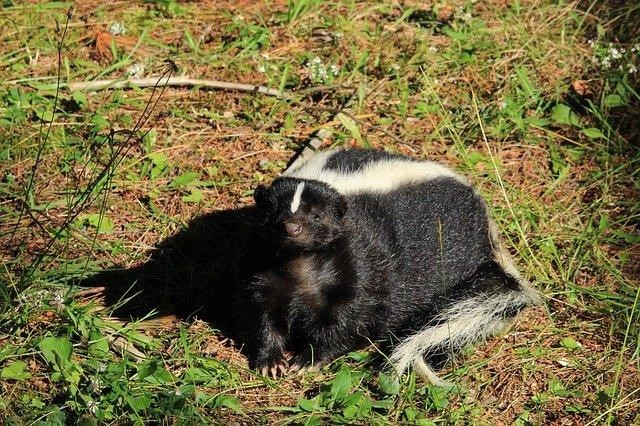
The most popular kind of skunk is commonly seen in Virginia.
Most of these species can be as huge as a house cat. They have white stripes, rounded ears, black eyes, and furry tails. They are mostly found in the eastern half of Virginia and commonly found in open areas, fields, or near water areas than in forests.
2. Eastern Spotted Skunk
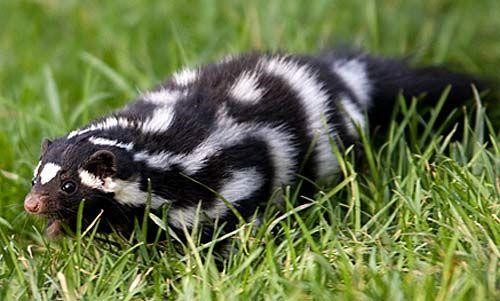
This type of skunk that can climb trees. They are more active and have physical features closer to weasels. It has 4 broken stripes on its back that look like spots and they are smaller than the striped skunks with 20 to 22 inches including their tail length.
3. Hog-Nosed Skunk
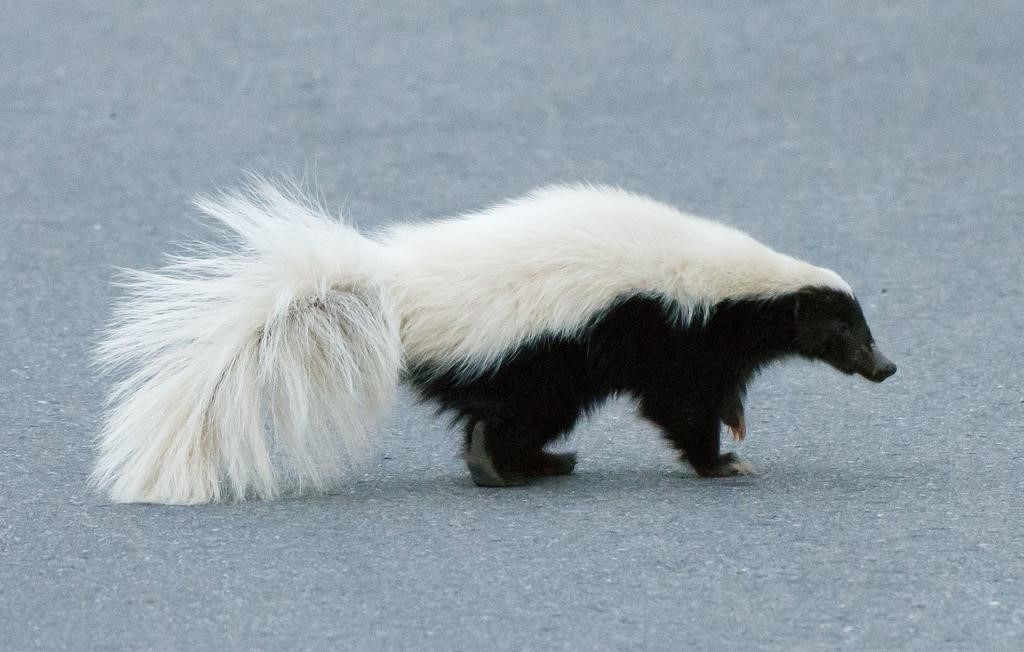
The largest type of skunk can reach a size of 31 inches and weigh about 2 to 4.5 kg. They’re native to America and have four subtypes.
Hog-nosed skunks are heavier and use it to their advantage by digging up roots and feast on beetles on the ground. They are also called rooter skunks and badger skunks due to their distinct behavior and size.
4. Hooded Skunk
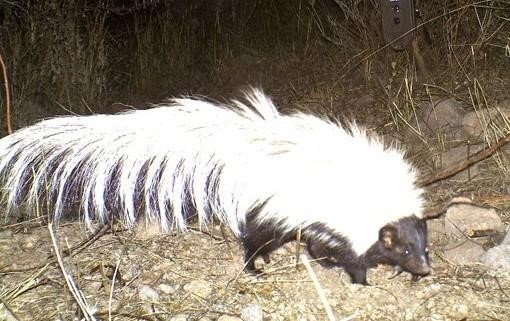
The fluffiest type of skunk that has a longer tail and bushier fur. Its name comes from the thick white fur that covers its neck. They’re mostly found in the Southwestern part of the US and Mexico.
They mostly love to eat vegetables and fruits more than insects but would certainly eat anything within the skunk diet if they have no other options.
Hooded skunks are known to host parasitic species such as fleas, nematodes, and roundworms that may spread pests in vegetable gardens and fields.
How Can Skunks Affect Your Property?
When colder seasons come and there are fewer insects and plants around, skunks may roam around your property and look for food. They can access your property in two ways: digging their way under the fence and climbing the fence.
Skunks may live in a burrow but those that are used to the presence of humans and animals may find it comfortable to stay under your porch, in your garage or tool shed.
At night they may lurk around your home looking for food or be a threat to some pets like birds, hamsters, and other small animals that fit their diet.
They have a strong sense of smell and may search around your trash bins for rotten fruits and vegetables. Since skunks have short legs, they may target food supplies located on lower cabinets and areas such as pet food.
Farmers can either skunks as their best friend or a foe for their livestock business.
Skunks know how to shove away chickens and feast on their eggs. Skunks may also have rabies that bitten farm animals may transmit to one another and even to humans.
How To Keep The Skunks Away From Your House?
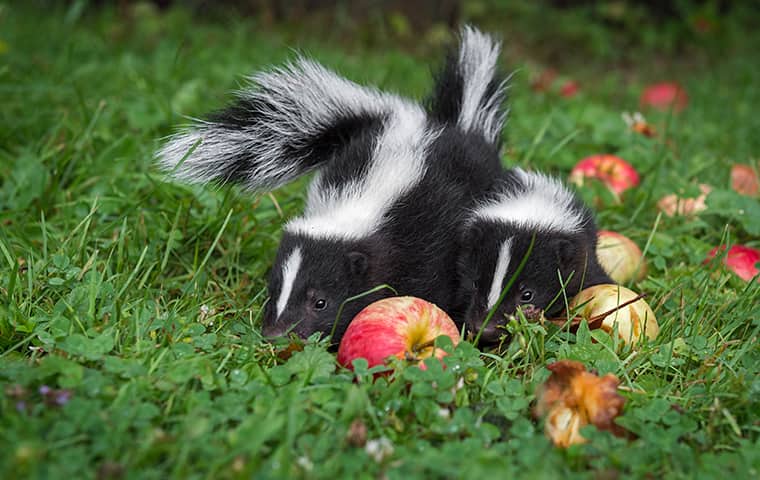
Learning the behaviors of skunks is the best way to detect them on your property and locate their hiding place. They’re entirely harmless to humans unless provoked, but they may steal food supplies and cause disturbances at home.
They may look cute to some but they have rabies and can pose threats to other smaller animals and beneficial insects.
So, if you suspect that a furry skunk is lurking around the area, here are some helpful tips to keep them away from your home:
1. Cover up The Holes And Potential Entrances on Your Fences
Skunks are more prone to be diggers than climbers. Keep that in mind when installing your fences and add a maximum of two feet of fence length buried underground.
You should also cover broken fences and close off worn-out mesh wires to keep the skunks out.
2. Remove Potential Skunk Den in Your Property
Skunks love the undisturbed low-lying areas where wood and rocks are stored.
If you see pockets of spaces around your house or shed, you may want to board them up, or else, you’ll have some furry tenants in there in no time.
3. Getting Rid of Pests Means Getting Rid of Skunks Too
Skunks love pests. While they’re a good ally for pest control, they may also follow the pest around where it propagates.
Control the pest in your property using pesticides or you may also contact pest control experts to thoroughly get rid of them.
Hornets nests living underground or in your ceiling not only pose harm for stings but also attract other animals like skunks.
4. Pet Food Leftovers Should Be Kept Inside The House
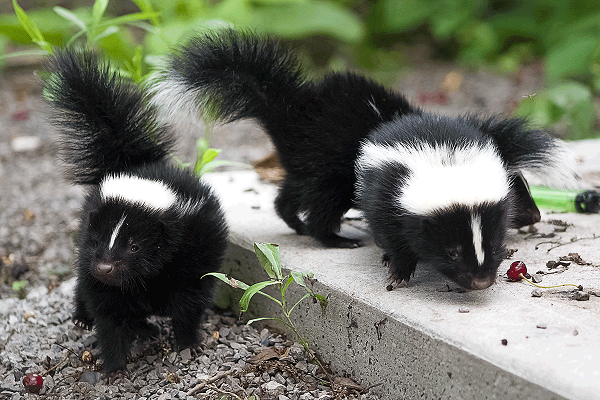
If your pets eat outside and don’t finish their meal. Skunks may finish it for them. If you see that they have some leftovers, keep their food trays inside.
Otherwise, you should feed them inside your house to avoid attracting hungry skunks around.
5. Keep Your Dog, Cat, and Bird Food on Top Shelves
Sneaky skunks may target your pet food placed in the cupboards. Keep the boxes or packs tightly sealed to avoid giving off the smell of the pet food.
6. Make The Skunk Leave With Loud Noises And Bright Lights
Skunks hate any kind of brightness and disturbances in their den. Expose or scare off the skunk sneaking into your home by playing loud music or creating loud noises to force them to walk away.
Just make sure the loud noises are subtle enough to make the skunks run away and not to drive your neighbors mad.
7. Use Skunk Repellents, Ammonia Rags & Naphthalene Balls To Drive The Skunks Away
The strong smell of ammonia and naphthalene affects the skunk’s sense of smell and may help drive them away from your property.
They may scare them away but you have to make sure that their den should no longer be accessible to skunks when they try to go back to it.
With plenty of food sources in the wild, skunks will not bother to go around humans and live inside their homes. However, due to the decline of their habitat and changes in season, their animal instincts will always lead them to potential food sources.
We hope that these tips can help keep the skunks away from your home. You don’t have to kill them or use unlawful and illegal means of controlling skunks since they can be scared away by some techniques mentioned above.
Frequently Asked Questions
Do skunks climb on roofs?
While squirrels can go through the higher levels of the house, skunks are not cut out for climbing. They can’t infiltrate your attic or ceilings unless they can access it through the door or stairs.
Do skunks sleep in trees?
Skunks sleep on fallen trees and not on the sturdy ones. Their paws are not equipped for climbing so they prefer the fallen trees or tree hollows that they can access on the ground.
What time of year do skunks have babies?
Baby skunks are usually born in May or June. Male and female skunks mate during warm seasons like mid-February to mid-March. The baby skunks stay in their dens for two months until they’re ready for the wildlife.
What’s the type of skunk that can climb trees and fences?
Eastern spotted skunk is the type of skunk that finds it easy to climb on trees and other high areas. They are smaller than other types of skunks, so it’s easier for them to carry their weight around.
Are skunks dangerous?
Skunks are harmless. However, they will defend themselves when you threaten them. Their bite can harm you because they have rabies. Other potential health risks associated with skunks, is they can be a host of fleas and roundworms that can spread to your dogs, cats, and even to you.
Final Thoughts
We hoped that this post has helped you understand how skunks behave around the wild and their behavior towards their food sources.
Today, more studies are supporting the idea that skunks are good for farming industries as a pest control since it naturally consumes farm pests as its main diet.
However, unless we learn how to understand them and work our way through their behavior, skunks will remain a pest for some of us.
If you find this post helpful, don’t forget to share it with your friends. Don’t let your friends harm the skunks or be infested by them in their homes by sharing your best practices from this post.
Comment on your experience with these furry animals below, and share with us what strategy worked best for you!
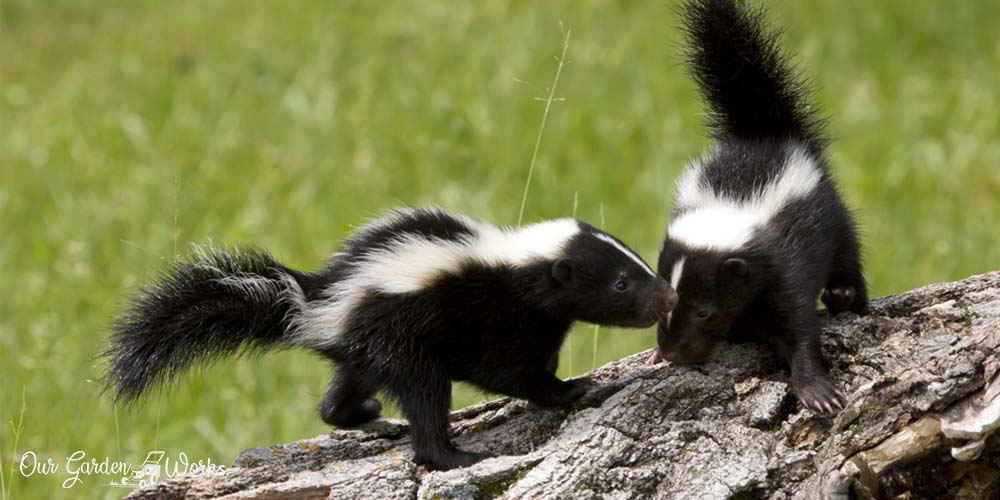
Hi
I used to have a large skunk that came to my porch every night to eat the food that my cat didn’t finish , she always came when I was out there in the evening , she must have gotten used to me cause she never sprayed or acted fearful and would eventually come right up to me .
I started leaving fruit out for her and one day was actually able to start getting her to eat out of my hand .
One night she even showed up with two babies !
If people just act calm and sensible around them their really no threat and honestly they are adorable .
I moved five years ago and still miss my Little (huge) Stinky 🙂
Thanks Ellie for sharing your story. Honestly, I really like squirrels too. ^^